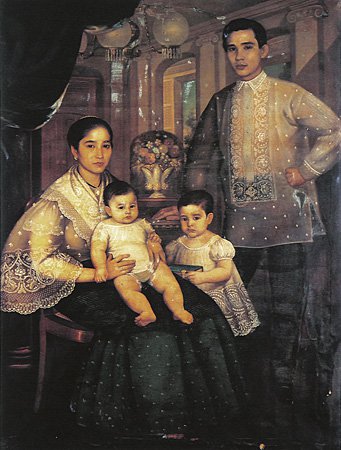Cultural Center of the Philippines
ENCYCLOPEDIA OF
PHILIPPINE ART
[The Quiason Family 1880]
Oil on canvas / Approximately 77 x 61 cm / Artist: Simon Flores / Bangko Sentral ng Pilipinas collection
This painting is a fine example of a 19th-century group portrait of an ilustrado (educated) family. In oil portraits such as this can be seen images of Filipinos as proud members of an emergent class possessing new economic power and creating their own space in the works of their time.
The family, consisting of the standing father and the seated mother with her two small children, are formally posed for the portrait in the 19th-century convention of representation. Their gaze and bodily stances are directed toward the artist who also occupies the position of the viewer. They are painted in full figure. The mother’s dark skirt and father’s equally dark-toned trousers, in contrast to their light upper clothing, have the effect of raising the figures and giving them an advantage of height over the viewer. Within the domestic setting of the rich interior, the standing male figure of the husband/father conveys the position of authority, enhanced by his straight posture and his arm akimbo forming a right angle to his waist. He stands slightly to the side in order to present his family; here the male assumes the active role of presentation. The wife/mother, in turn, presents her children who occupy the center of the painting. They have a formal, unsmiling expression in order to impress their importance on the viewer and to convey a high moral tone as models to be emulated. Following the convention of ilustrado portraiture, the artist painstakingly recorded their Sunday finery in all the minutiae of embroidery, as well as transparent textures of their costumes, jewelry, and accessories in the style of miniaturismo. The grouping has for its center the flowers in a glass vase, symbol of beauty and abundance. The globular chandeliers and the open door create an illusion of depth in the elegant interior, while the velvet curtain at the left and the classical column at the right close the composition.
Written by Alice G. Guillermo
